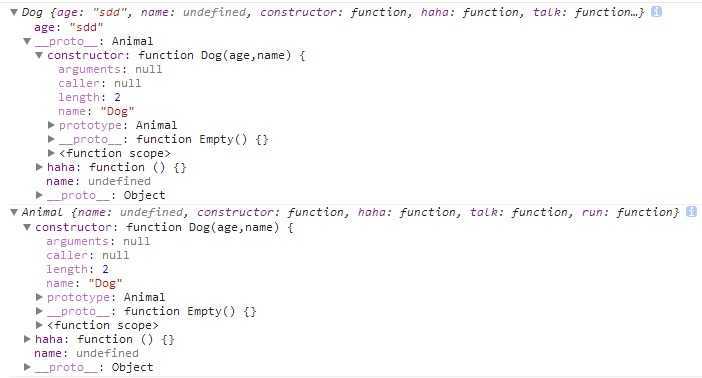标签:style blog http java color 使用
js提供了一些内置类,如Array String Function等,只要有类就有原型。
1,function ,属性包括 arguments, caller,length,name ,prototype,__proto__,
2,prototype,属性又分为constructor: function () {},__proto__: Object,
3,__proto__从别的原型链继承过来可以直接用的,prototype是要加在自己原型链上的,供别人调用,或者直接实例化后,别人可以直接调用转成__proto__的。
__proto__是永远存在的,都指向下一层,最终是Object。
4,function 和prototype本身都含__proto__,其实本身也都是对象,自己继承过来的,他们2个也是基本类型的实例。
js的instanceof是根据prototype来判断两个对象是否存在继承关系,A instanceof B, js会沿着A的原型链查找 直到找到A.__proto__ === B.prototype 返回true。
一句话__proto__一层层都是指向继承的,最终到基本类型上。
一,function
function定义的是一个Object(对象),而且还是一个很特殊的对象,这个使用function定义的对象与使用new操作符生成的对象之间有一个重要的区别。
这个区别就是function定义的对象有一个prototype属性,使用new生成的对象就没有这个prototype属性。
prototype是function的一个属性。所有通过function 来定义的对象,都有prototype这个属性。
通过{}定义的对象字面量是没有prototype的,如
|
1
2 |
var
a ={1:"a"}console.log (a.prototype); |
结果是undefined,原因是他已经实例化,
|
1
2 |
var
a ={1:"a"}console.log (a.__proto__); |
结果是 Object {} ,相当于new 后的。
function 的length 参考http://www.cnblogs.com/52cik/p/js-function-length.html
函数的 length 属性只能得到他的形参个数,而无法得知实参个数。
function 是Object的实例,他自己的__proto__是Object.prototype
|
1
2
3
4
5
6
7 |
var
A =function
(age ){ this.age = age; }A.prototype.haha = function
(){}console.log( A instanceof
Object)// true console.log( typeof
A) // functionconsole.log (Object.prototype.toString.call(A)) //[object Function] |
数组类型typeof 是object,数组跟object更加接近
|
1
2
3 |
var
B =[1,2,3]console.log(typeof
B)//objectconsole.log(typeof
A)//function |
|
1
2
3
4
5
6
7
8
9
10
11 |
var
A =function
(age ){ this.age = age; }A.prototype.haha = function
(){}var
B =[1,2,3]console.log(typeof
A)//functionconsole.log(A instanceof
Function)//trueconsole.log(A instanceof
Object)//trueconsole.log(typeof
B)//objectconsole.log(B instanceof
Array)//trueconsole.log (Object.prototype.toString.call(A)) //[object Object] |
caller:
返回一个对函数的引用,该函数调用了当前函数。
functionName.caller
functionName 对象是所执行函数的名称。
说明
对于函数来说,caller 属性只有在函数执行时才有定义。如果函数是由顶层调用的,那么 caller 包含的就是 null
。如果在字符串上下文中使用 caller 属性,那么结果和 functionName.toString 一样,也就是说,显示的是函数的反编译文本。
|
1
2
3
4
5
6
7
8
9 |
var
A =function
(age ){ this.age = age; console.log(A.caller) }A.prototype.haha = function
(){}var
B = function(type){ A(); }B(); |
返回,最后是B的函数,谁调用我了,返回谁
function (type){ A(); }
[function.]arguments.callee
可选项 function 参数是当前正在执行的 Function 对象的名称。
说明 : callee 属性的初始值就是正被执行的 Function 对象。
callee 属性是 arguments
对象的一个成员,它表示对函数对象本身的引用,这有利于匿名函数的递归或者保证函数的封装性,例如下边示例的递归计算1到n的自然数之和。而该属性仅当相关函数正在执行时才可用。还有需要注意的是callee拥有length属性,这个属性有时候用于验证还是比较好的。arguments.length是实参长度,arguments.callee.length是
形参长度,由此可以判断调用时形参长度是否和实参长度一致。
二、prototype
本身含constructor,__proto__
|
1
2
3
4
5 |
var
A =function
(age ){ this.age = age; }A.prototype.haha = function
(){}console.log (A.prototype) ; |
可以看到的内容
Object {haha: function}
constructor: function (age ){
arguments: null
caller: null
length: 1
name: ""
prototype: Object
__proto__: function Empty() {}
<function scope>
haha: function (){}
__proto__: Object
constructor实际指向的是 函数创建时的那个function。
|
1
2
3
4
5
6
7
8
9
10
11
12
13
14
15
16
17
18
19
20 |
function
Animal(name) { this.name = name;}Animal.prototype = { talk: function() {}, run: function() {}}function
Dog(age,name) { //Animal.call(this,name) this.age=age;}// 要让 Dog 继承 Animal, 只需:__ 2个_Dog.prototype = new
Animal ; // 实例化后Dog.prototype.constructor = Dog;//手工的把constructor给暴露出来了。可以通过dog.constructor来调用//Dog.prototype = new Animal ; //Animal的构造函数和自己的prototype也都放到Dog上Dog.prototype.haha = function
() {};//Dog.prototype.haha.tata = 4;var
dog = new
Dog("sdd","bbb"); var
animal = new
Animal("aaaa");console.log(dog);<br>console.log(Dog.prototype); |
返回结果如下:

dog.__proto__.__proto__ === Animal.prototype 返回的true。
原型链作为实现继承的主要方法,其基本思想是:让原型对象等于另一个类型的实例,这样原型对象将包含一个指向另一个原型的指针,相应的,另一个原型中也包含着一个指向另一个构造函数的指针,假如另一个原型又是另一个类型的实例,如此层层递进,就构成了实例与原型的链条,这个链条就称之为原型链.
另外一个问题,prototype是存储放到共享区域内的,可以共同修改。
|
1 |
Dog.prototype = Animal.prototype的方法集成,如果子类重写了父类的方法,父类也会受到影响。 |
推荐的用法是
|
1 |
Dog.prototype.__proto__ = Animal.prototype |
不用写Dog.prototype.constructor = Dog了,constructor 没有被覆盖,Dog本身就有了。
参考可以看下下面的例子, http://www.cnblogs.com/qiantuwuliang/archive/2011/01/08/1930548.html
|
1
2
3
4
5
6
7
8
9
10
11
12
13
14
15
16
17
18
19
20
21
22
23
24
25
26
27
28
29 |
代码 function
Person(name) { this.name=name; this.showMe=function() { alert(this.name); } }; Person.prototype.from=function() { alert(‘I come from prototype.‘); } var
father=new
Person(‘js‘);//为了下面演示使用showMe方法,采用了js参数,实际多采用无参数 alert(father.constructor);//查看构造函数,结果是:function Person(name) {...}; function
SubPer() { } SubPer.prototype=father;//注意这里 SubPer.prototype.constructor=SubPer; var
son=new
SubPer(); son.showMe();//js son.from();//I come from prototype. alert(father.constructor);//function SubPer(){...} alert(son.constructor);//function SubPer(){...} alert(SubPer.prototype.constructor);//function SubPer(){...} |
关于prototype是共享和prototype的作用域问题
|
1
2
3
4
5
6
7
8
9
10
11 |
function
Tree(x){ this.value = x; }Tree.prototype.children = [1,2];var
a =new
Tree(2);a.children=3;var
b = new
Tree(4);b.children=5;var
c = new
Tree(6); console.log (c.children)//[1,2] |
这个对 a.__proto_ 没有做修改,最后依然是 a.__proto_ === Tree.prototype
a.children=3,相当于在a这个对象下面直接加了个children的属性。
|
1
2
3
4
5
6
7
8
9
10
11 |
function
Tree(x){ this.value = x; }Tree.prototype.children = [1,2];var
a =new
Tree(2);a.children.push("3");var
b = new
Tree(4);b.children.push("5");var
c = new
Tree(6); console.log (c.children);//[1,2,"3","5"] |
a.children相当于开始是undefined,如果直接复制的话,就是在a对象下加属性了,然后在.操作,相当于从原型链上去取了。
prototype 和function关系等总结,布布扣,bubuko.com
标签:style blog http java color 使用
原文地址:http://www.cnblogs.com/danghuijian/p/3755755.html